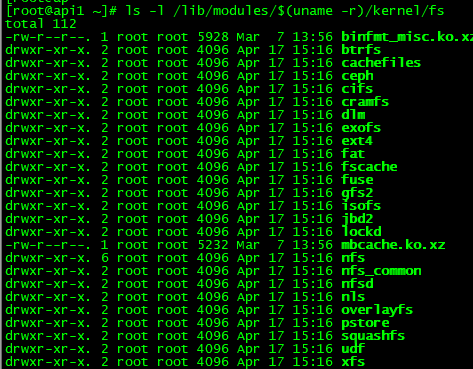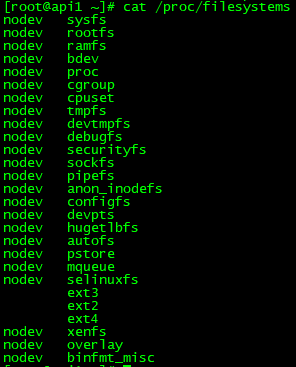In-depth understanding of Linux's standard file system (Ext2/Ext3/Ext4)
Ext
The full name is Linux extended file system, extfs, which is the Linux extended file system. Ext2 represents the second generation file extension system, Ext3/Ext4 and so on. They are all upgraded versions of Ext2, but with the addition of log function, and They are backward compatible with each other, so Ext2 is called an indexed file system, and Ext3/Ext4 is called a journaled file system.
Note: Linux supports many file systems, including Network File System (NFS) and Windows’ Fat file system.
Check the file systems supported by Linux: ls -l /lib/modules/$(uname -r)/kernel/fs

View the file systems supported by Linux (loaded into memory): cat /proc/filesystems

Core Design
Data area
These elements are relatively stable and will be fixed after the disk is formatted.
1, inode (index node)
Record the permissions, attributes of the file and the number of the block where the data is located. Each file has one and only one inode. Each inode has its own number. The inode can be simply understood as a document index.
2. block(data block)
The stored file content is also called a data block. Each block has its own number. The unit block capacity supported by Ext2 is only 1k, 2k, and 4k.
Note: In order to facilitate inode recording, the block size has been fixed after the disk is formatted. Each block can only store the data of one file. If the file is too large, it will occupy multiple blocks; if the file is too small, the remaining space of the block cannot be used, which will cause a waste of disk space. Therefore, after the disk is partitioned, the file Before formatting your system, think carefully about the expected usage of the file system.
Metadata
These elements are designed to maintain the file system status. They mainly represent the dynamic configuration information of the file system and are descriptive information.
1. superblock(superblock)
Record the overall information of the file system (filesystem), including the total amount, usage, remaining amount, size of inode/block, as well as the format and related information of the file system.
Note: All basic information of the entire file system is recorded in the superblock. Its size is generally 1024Bytes. If it dies, it will take a lot of time to remedy it! ! !
2. block group
Just imagine, if our disk capacity reaches hundreds of G, when we format it, the inode and block will be very large. In order to facilitate management, the Ext file system introduces block groups when formatting. The concept is that each block group maintains an independent inode/block/superblock and has a fixed number of blocks, which is divided into a group of basic sub-file systems.
Note: superblock is too important for the file system, but there is only one superblock in the file system, so in addition to the first block group containing the superblock, subsequent block groups may contain backup superblocks. The purpose is to avoid the single superblock. Point cannot be rescued.
3. block bitmap (block comparison table)
A block can only be used by one file. When we add a new file, we must use a new block to record the file data. So how to quickly know which blocks are new? Which blocks are already used? The block bitmap is designed in this way to record all used and unused block numbers. Similarly, when we delete a file, we first find the corresponding block number from the block bitmap, then update the flag to unused, and finally release the block.
inode bitmap(inode comparison table)
The same design concept as block bitmap, except that it records used and unused inode numbers, which will not be described here.
group descriptor
Describe the block numbers at the beginning and end of each section (block group), and explain which block numbers each section (inodemap, blockmap, inode table) is between.
List all formatted devices in the current system: blkid

Select a formatted device and view the detailed information of the file system: dumpe2fs /dev/vda1


Note: The above Magic signature is 0xEF53, indicating that our disk partition is an ext2 and ext3 file system. Similar to the Magic at the beginning of the file, you can determine the file type.
Summarize
The Ext family is the most widely supported and complete file system in Linux. After we format the disk, all inode/block/metadate and other data have been planned for us, so that the system can be used directly without any Dynamic configuration is also its best feature, but this is also its most significant shortcoming. The larger the disk capacity, the slower the formatting. Centos7.x has chosen xfs as the default file system.
The above is the detailed content of In-depth understanding of Linux's standard file system (Ext2/Ext3/Ext4). For more information, please follow other related articles on the PHP Chinese website!

Hot AI Tools

Undresser.AI Undress
AI-powered app for creating realistic nude photos

AI Clothes Remover
Online AI tool for removing clothes from photos.

Undress AI Tool
Undress images for free

Clothoff.io
AI clothes remover

AI Hentai Generator
Generate AI Hentai for free.

Hot Article

Hot Tools

Notepad++7.3.1
Easy-to-use and free code editor

SublimeText3 Chinese version
Chinese version, very easy to use

Zend Studio 13.0.1
Powerful PHP integrated development environment

Dreamweaver CS6
Visual web development tools

SublimeText3 Mac version
God-level code editing software (SublimeText3)

Hot Topics
 1378
1378
 52
52
 How to start nginx in Linux
Apr 14, 2025 pm 12:51 PM
How to start nginx in Linux
Apr 14, 2025 pm 12:51 PM
Steps to start Nginx in Linux: Check whether Nginx is installed. Use systemctl start nginx to start the Nginx service. Use systemctl enable nginx to enable automatic startup of Nginx at system startup. Use systemctl status nginx to verify that the startup is successful. Visit http://localhost in a web browser to view the default welcome page.
 How to check whether nginx is started
Apr 14, 2025 pm 01:03 PM
How to check whether nginx is started
Apr 14, 2025 pm 01:03 PM
How to confirm whether Nginx is started: 1. Use the command line: systemctl status nginx (Linux/Unix), netstat -ano | findstr 80 (Windows); 2. Check whether port 80 is open; 3. Check the Nginx startup message in the system log; 4. Use third-party tools, such as Nagios, Zabbix, and Icinga.
 How to start nginx server
Apr 14, 2025 pm 12:27 PM
How to start nginx server
Apr 14, 2025 pm 12:27 PM
Starting an Nginx server requires different steps according to different operating systems: Linux/Unix system: Install the Nginx package (for example, using apt-get or yum). Use systemctl to start an Nginx service (for example, sudo systemctl start nginx). Windows system: Download and install Windows binary files. Start Nginx using the nginx.exe executable (for example, nginx.exe -c conf\nginx.conf). No matter which operating system you use, you can access the server IP
 How to solve nginx403
Apr 14, 2025 am 10:33 AM
How to solve nginx403
Apr 14, 2025 am 10:33 AM
How to fix Nginx 403 Forbidden error? Check file or directory permissions; 2. Check .htaccess file; 3. Check Nginx configuration file; 4. Restart Nginx. Other possible causes include firewall rules, SELinux settings, or application issues.
 How to solve nginx403 error
Apr 14, 2025 pm 12:54 PM
How to solve nginx403 error
Apr 14, 2025 pm 12:54 PM
The server does not have permission to access the requested resource, resulting in a nginx 403 error. Solutions include: Check file permissions. Check the .htaccess configuration. Check nginx configuration. Configure SELinux permissions. Check the firewall rules. Troubleshoot other causes such as browser problems, server failures, or other possible errors.
 How to check whether nginx is started?
Apr 14, 2025 pm 12:48 PM
How to check whether nginx is started?
Apr 14, 2025 pm 12:48 PM
In Linux, use the following command to check whether Nginx is started: systemctl status nginx judges based on the command output: If "Active: active (running)" is displayed, Nginx is started. If "Active: inactive (dead)" is displayed, Nginx is stopped.
 How to clean nginx error log
Apr 14, 2025 pm 12:21 PM
How to clean nginx error log
Apr 14, 2025 pm 12:21 PM
The error log is located in /var/log/nginx (Linux) or /usr/local/var/log/nginx (macOS). Use the command line to clean up the steps: 1. Back up the original log; 2. Create an empty file as a new log; 3. Restart the Nginx service. Automatic cleaning can also be used with third-party tools such as logrotate or configured.
 How to solve nginx304 error
Apr 14, 2025 pm 12:45 PM
How to solve nginx304 error
Apr 14, 2025 pm 12:45 PM
Answer to the question: 304 Not Modified error indicates that the browser has cached the latest resource version of the client request. Solution: 1. Clear the browser cache; 2. Disable the browser cache; 3. Configure Nginx to allow client cache; 4. Check file permissions; 5. Check file hash; 6. Disable CDN or reverse proxy cache; 7. Restart Nginx.




